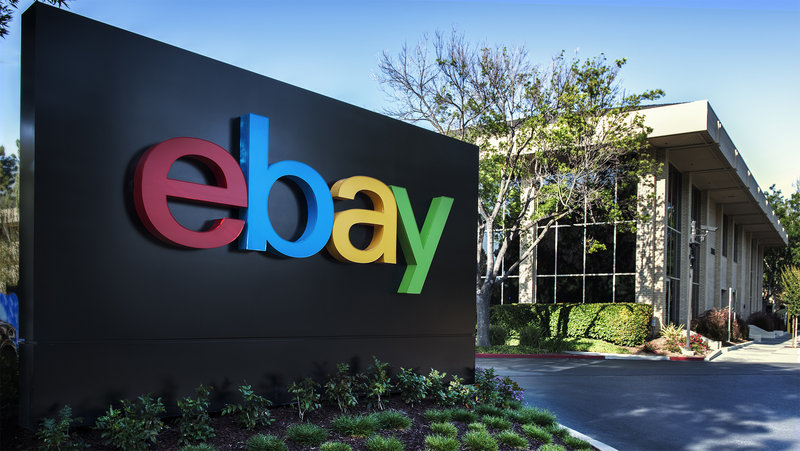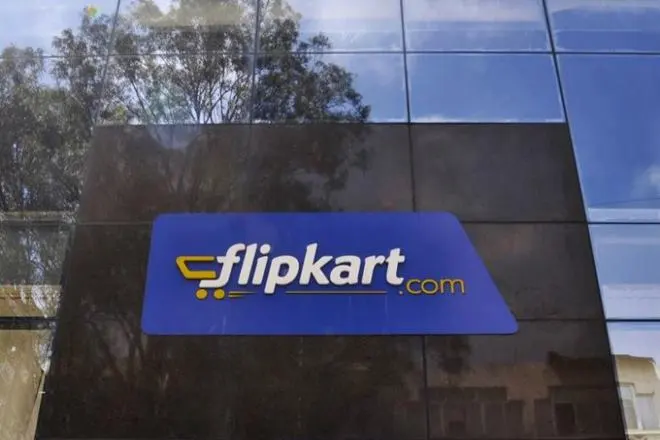eBay and Flipkart Complete Exclusive Agreement to Jointly Address the eCommerce Market Opportunity in India
Press Release

Accelerating and maximizing the opportunity in India in partnership with Flipkart.

UPDATE : eBay and Flipkart have completed their transaction announced on April 10, 2017. In exchange for an equity stake in Flipkart, eBay has made a $500 million cash investment in and sold its eBay.in business to Flipkart. Effective immediately, Flipkart will own and operate eBay.in. Additionally, the companies are moving forward to jointly pursue cross-border trade opportunities to make eBay’s global inventory accessible to more India consumers, while eBay’s millions of active buyers globally will have access to more unique Indian inventory provided by Flipkart.
The below release was originally published on April 10, 2017:
San Jose, CA and Bangalore, India – eBay Inc. (NASDAQ: EBAY), a global commerce leader, and Flipkart, a leading eCommerce company in India, have agreed to jointly pursue eCommerce opportunities in the Indian market. In exchange for an equity stake in Flipkart, eBay will make a $500 million cash investment in and sell its eBay.in business to Flipkart. Flipkart will own and operate the eBay.in business upon the close of the transaction. eBay and Flipkart have also entered into an exclusive agreement in which they will jointly pursue cross-border trade opportunities to make eBay’s global inventory accessible to more India consumers, while eBay’s millions of active buyers globally will have access to more unique Indian inventory provided by Flipkart.
“The combination of eBay’s position as a leading global eCommerce company and Flipkart’s market stature will allow us to accelerate and maximize the opportunity for both companies in India,” said Devin Wenig, President and CEO of eBay Inc. “eBay is committed to winning in India in partnership with Flipkart. Our exclusive global trade partnership will allow eBay and Flipkart to reach even more consumers around the world."
“This partnership between Flipkart and eBay is the coming together of two pioneering innovators who have disrupted commerce by applying technology. It bodes well for Indian and global customers, sellers and the wider eCommerce ecosystem. eBay.in has built a strong presence in India over the years and we hope to take it to greater heights as part of the Flipkart group,” said Binny Bansal, Group CEO, Flipkart.
Upon the close of the transaction, which is expected later this year, Flipkart will acquire eBay’s buyers in India. eBay will remove the number of active buyers in India from its reporting during the quarter in which the transaction closes. eBay does not expect this transaction to have a material impact on its guidance provided on January 25, 2017.
Forward-Looking Statements
This press release contains forward-looking statements relating to, among other things, the future performance of eBay Inc. and its consolidated subsidiaries. These statements are based on eBay’s current expectations, forecasts and assumptions and involve risks and uncertainties. Actual results could differ materially from those predicted or implied in this press release for a variety of reasons. You can find more information about risks, uncertainties and other factors that could affect our operating results in our most recent Annual Report on Form 10-K and subsequent quarterly reports on Form 10-Q, copies of which may be obtained by visiting eBay’s Investor Relations website at https://investors.ebayinc.com or the SEC's website at www.sec.gov . You should not rely on any forward-looking statements. All information in this press release is as of April 10, 2017, and we do not intend and undertake no duty to update this information.
eBay Inc. (NASDAQ: EBAY) is a global commerce leader including the Marketplace, StubHub and Classifieds platforms. Collectively, we connect millions of buyers and sellers around the world, empowering people and creating opportunity through Connected Commerce. Founded in 1995 in San Jose, Calif., eBay is one of the world's largest and most vibrant marketplaces for discovering great value and unique selection. In 2016, eBay enabled $84 billion of gross merchandise volume. For more information about the company and its global portfolio of online brands, visit www.ebayinc.com .
About Flipkart Group
The Flipkart Group is India’s largest e-commerce marketplace and includes group companies Flipkart, Myntra, Jabong and PhonePe. Launched in October 2007, Flipkart offers over 80 million products across 80+ categories and is known for pioneering services such as Cash on Delivery, No Cost EMI and easy returns – innovations that made online shopping more accessible and affordable for millions of customers. Together with Myntra and Jabong, which hold dominant positions in the online fashion market, and PhonePe, India’s first UPI based payment app with offerings in nine languages, the Flipkart Group has led the transformation of commerce in India.
Topics: Announcements , Financial
- PRO Exclusives
- Free Newsletter
- Corporate Subscription
Flipkart-eBay potential merger: There is more to it than meets the eye
By Binu Paul
- 24 Mar 2017

Share article on

Related Articles

Zoomcar to launch cab rental product to test demand in larger market

MENA Digest: UAE startups lead funding activity; CredibleX, Anghami secure $55 mn each

Peak XV makes one of its best exit moves from India portfolio

Nazara's subsidiary Nodwin acquires AFK Gaming

Beyond Capital backs Clinikk, Fasal; Seekho, five other startups get funding

Belgium's KOIS to set up fund for bets in assistive medtech sector

Pi Ventures bets on Quanfluence; Kirana Pro raises early-stage funding
Google News
Follow VCCircle on Google News for the latest updates on Business and Startup News
You are running a browser with JavaScript Disabled Please enable JavaScript on your browser to continue. Thanks.
You agree to our cookie policy by using this website. More Info Got it
DataWeave.com uses cookies to ensure we give you the best experience on our website. More Info . Ok

Advantage Flipkart: The Motives Behind Acquiring eBay India
16th may, 2017.

By Amit Tripathi
Flipkart recently acquired eBay’s India business in an announcement that made a huge splash across the country. With Flipkart already having acquired Myntra and Jabong, and talks of a Snapdeal acquisition picking up steam, this level of consolidation comes clearly as a direct response to internet behemoth Amazon’s aggressive expansion strategies in India.
With this acquisition play, Flipkart stands to gain primarily on two fronts.
eBay’s Seller Network
Firstly, eBay has built a strong network of authorized and highly-rated global sellers, something that Flipkart can leverage to drive increased sales and market share.
Per Flipkart’s announcement to the press — “Flipkart and eBay have signed an exclusive cross-border trade agreement, as a result of which customers of Flipkart will gain access to the wide array of global inventory on eBay, while eBay’s customers will have access to unique Indian inventory provided by Flipkart sellers. Thus, sellers on Flipkart will now have an opportunity to expand their sales globally.”
At DataWeave, we ran our proprietary data aggregation and analysis algorithms over eBay’s websites and unearthed some interesting numbers about their seller network.

eBay.com has a global network of 17,361 sellers, 41% of whom ship to India. Therefore, this acquisition opens the door for Flipkart to gain access to over 7000 global eBay.com sellers who ship to India — a huge boost to the range of products Flipkart can host on its platform.
Additionally, a sizable chunk — 14% — of eBay.in sellers ship to international destinations. This provides Flipkart with opportunities to expand its reach globally.
The other, rather lesser known advantage that Flipkart stands to gain from this acquisition is in the refurbished and pre-owned goods space.
The Emergence of Refurbished and Pre-Owned Goods
The market for refurbished and pre-owned products is estimated to be between $15 billion and $20 billion globally, with exponential growth forecast for the near future.
Part of the reason for growth in this segment is it yields higher returns on investment for retailers. While a retailer typically earns 3–5% margin by selling a new smartphone, refurbished smartphones fetch 7–8% margin, and pre-owned smartphones 9–10%.
The Hidden Advantage
eBay has established itself over the years as a reliable source of refurbished and pre-owned products, with impressive levels of authentication and warranties. We did a quick analysis of eBay.in, Flipkart, and Amazon to identify their relative strengths in this space.

Unsurprisingly, Flipkart has close to zero refurbished or pre-owned products hosted on their website. With Amazon, 12% of mobile phones and 9% of Books on their website are refurbished or pre-owned, the largest selling categories in this space.
eBay.in, though, has a significant share of these products across categories — 95% of books & magazines, 36% of mobile phones, and 28% of televisions — a substantial portion of eBay’s business.
With this acquisition, Flipkart can now take a gigantic step into the relatively more profitable and exponentially growing refurbished and pre-owned products space. It will also be a strong competitive differentiator for the company as they go head to head with Amazon in India.
While the refurbished and pre-owned goods space poses a series of advantages for retailers, it sits well with consumer preferences as well, drawing more shoppers, and retaining existing ones.
Influence of Shopping Behavior on Product Assortment
Refurbished and pre-owned products provide consumers with attractive alternatives, both in terms of price and variety. Shoppers today explore and research new, pre-owned and refurbished products, all at the same time, and compare prices across e-commerce websites before deciding on a purchase.
As a result, comprehensive product assortments across price ranges and attributes drive higher engagements, traffic and improve customer conversion and retention rates, as they cater to a more diverse set of consumers.
For modern retailers, this reinforces the importance of investing in tools that enable to them to identify high-value gaps in their assortment and plug them. To achieve this, they need up-to-date, accurate data, at scale, on the assortments of their competitors.
DataWeave’s Assortment Intelligence solution is designed to give retailers near-real-time insights on competing retailers’ product mix and suggests product additions to retailer catalogs.
Click here to know more about how Assortment Intelligence can help your retail business manage assortment efficiently and profitably.
- Amit Tripathi 16th May, 2017
E Commerce Strategy
Thank you for your interest.
Download Article
If your download does not start automatically click the button above.
Recommended Posts
Dataweave launches pricingpulse: empowering retail leaders with comprehensive an....
DataWeave’s PricingPulse is the first and only pricing view in the industry to...
Praveen Sheethalnath | 29th Aug, 2023
Competitive Pricing and Availability Trends of South Africa’s Leading Retailer...
South Africa’s eCommerce market is primed for robust growth in 2023 and beyond...
Prashant Dixit | 14th Apr, 2023
Back-to-School 2024 Pricing Strategies: What Retailers and Brands Need to Know...
Explore 2024 back-to-school retail trends: pricing strategies, discount analysis...
DataWeave Marketing | 12th Sep, 2024
The Rise of On-Demand Grocery Delivery after the Pandemic...
According to Acosta’s report, post-pandemic, 45% of customers prefer onlin...
Varun Sharma | 5th Apr, 2022
Subscribe to receive updates
Thank you for Subscribing - Team DataWeave
Book a Demo
Download Report
If your download does not start automatically, click the button above.
For accounts configured with Google ID, use Google login on top. For accounts using SSO Services, use the button marked "Single Sign-on".

Flipkart completes merger with eBay.in
Flipkart announced on tuesday that it has successfully concluded the merger transaction with ebay in india, to make ebay.in a part of the flipkart group..

Flipkart announced on Tuesday that it has successfully concluded the merger transaction with eBay in India, to make eBay.in a part of the Flipkart group. The merger may pose a payment glitch for sellers registered on eBay.in for the time being. Flipkart had announced in April this year that in exchange of an equity stake in Flipkart, eBay would invest $500 million in the Indian e-commerce major and sold its India business (eBay.in) to Flipkart.
Together with Microsoft and Tencent, eBay partook in the funding round in Flipkart that saw the company raising $1.4 billion in April this year. “Effective immediately, Flipkart will own and operate eBay.in, which will remain an independent entity as a part of Flipkart. Additionally, both companies are also partnering to leverage opportunities in cross-border trade,” the company said in a statement. The cross border trade will help the home grown e-commerce major to ward off competition from Amazon that realised the potential of on-boarding Indian exporters and last year launched its global selling programme in India . Amazon has currently more than 20,000 Indian sellers listing over 45 million products for the overseas market . Now Flipkart has the chance to have a crack at this market through its tie up with eBay.

Meanwhile, in a communication to sellers, eBay India said that sellers on its platform may experience some delay in getting their remittances due to the merger process. The communication to sellers, said, “As communicated to you earlier, eBay India Private Limited is sold to Flipkart and effective August 1, 2017, Flipkart is your new contracting entity for your transactions on the http://www.ebay.in website. We are in the process of updating our banking and remittance processes which changes are consequent to the change of ownership and therefore can be implemented only after August 1, 2017. Due to these changes necessitated by the change of ownership, it is likely that you may experience a delay in receiving remittance for your transactions on eBay.in.”

Kalyan Krishnamurthy, CEO, Flipkart, said: “Being an early mover, eBay.in has a unique standing in the Indian e-commerce market, which is a great addition to Flipkart’s leadership position. Our coming together directly benefits Indian customers and sellers for whom we want to provide the best possible e-commerce experience. This is a step in that direction.”
- Stock Market Stats
- Assembly Elections
- Budget 2024
- Stock Market Quotes
- Mutual Fund
- Stock Stats
- Top Gainers
- CaFE Invest
- Investing Abroad
- Gold Rate in India
- Silver Rate in India
- Petrol Rate in India
- Diesel Rate in India
- Express Mobility
- Banking & Finance
- Mutual Funds
- Travel & Tourism
- Brand Wagon
- Entertainment
- Web Stories
- Auto Web Stories
- Infographics
- Today’s Paper
- Personal Finance Print
- PRIVACY POLICY
- TERMS AND CONDITIONS
- IPO’s Open and Upcoming 12
- Top Indices Performance
- Stock Analysis
- Financial Literacy
- Gold Rate Today
- NSE Top Gainers 448
- NSE Top Losers 2368
- BSE Top Gainers 1726
- BSE Top Losers 3556
- NSE 52-Week High 0
- NSE 52-Week Low 0
- BSE 52-Week High 0
- BSE 52-Week Low 0
- NSE Price Shocker
- NSE Volume Shocker
- BSE Price Shocker
- BSE Volume Shocker
- NSE Sellers
- BSE Sellers
- Silver Rate Today
- Petrol Rate Today
- Diesel Rate Today
Flipkart And Myntra Merger Case Study: Reasons And Post-Merger
Flipkart and Myntra merger case study brought the two biggest e-tailers of India together. The merger made it possible for both investors Flipkart and Myntra to strengthen their parts. Thus Flipkart strengthened its structure of product offering while Myntra got a chance to leverage its infrastructure. Moreover, the Flipkart and Myntra merger case study was taken with a vision to compete with Amazon.
Introduction
Briefly, the Indian online retail industry holds 0.55% of the overall retail industry which is about Rs. 25.3 billion and includes unorganized and organized details. The industry players mostly followed a non-inventory model or an inventory-based model which is commonly termed a marketplace model. In August 2014, the companies that adopted the inventory-based model are(all were online retailers ):
- Myntra.com
- Firstcry.com
- zovi.com
While those who followed the non-inventory based model are(marketplaces):
- Flipkart.com
- Snapdeal.com
- eBay. in
- Amazon. in
The thing happened in mid-summer of 2014 when India’s biggest e-tailer Flipkart announced the Indian e-commerce industry – the merger with Myntra, its competition and leading company in the apparel and fashion segments, a zone in which Flipkart was lagging behind other players.
At this moment, the co-founders of Flipkart ( Binny Bansal and Sachin Bansal) claimed that they know the future of fashion is e-commerce in India.
Moreover, Myntra has significant domain knowledge with an excellent team along with good relations with lifestyle brands.
The Flipkart and Myntra merger case study can strengthen respective positions in different areas. Although after Flipkart and Myntra merger case study both the companies worked as individual entities and decided to grow together as leaders in the lifestyle and fashion industry.
Also, there were a lot of sayings about the Flipkart and Myntra merger case study by different experts where they highlighted that the consolidation may not be good from the customer’s point of view.
Brief Of Flipkart
Flipkart or flipkart.com was initially started by two ex-amazon employees, Binny Bansal and Sachin Bansal in 2007 with a total investment of Rs. 4 lakh. Firstly, the company started by selling books and got its very first order after 4 months.
As a result, by December 2009, Flipkart grew up as the largest bookstore in India along with which it started selling different products as well.
Further, by 2010, Flipkart started with mobile phones, DVD’s/VCD’s, etc. by march 2011, Flipkart had a GMV(gross merchandise value) of about US$10 million.
As it increased its pace, the company added various categories like laptops, cameras, health care, e-learning, clothing, personal products, and home appliances.
- Convenience
- Earning customers trust
- Regular penetration in all segments
- Internet reach
- Excellent service
- Inflow of investment
Flipkart now deals in everything from consumer goods to apparel along with its supply network being valued at around 10000 crores. Now, the question arises why there was still a need to acquire Myntra.
Brief Of Myntra
Being a leader in fashion e-tail, Myntra or Myntra.com was the idea of 2 flatmates namely, Ashutosh Lawania and Mukesh Bansal in Bengaluru.
Further, two more founders joined the same year namely, Raveen Sastry and Vineet Saxena.
Initially, Myntra was an on-demand personalization platform online for customized services where the customers used to personalize their demands like diaries, keychains, T-shirts, etc.
Funding For Myntra
By October 2007, Myntra got its first funding said to be an undisclosed amount from accel and Sasha Mirchandani. As time passed the company received a series of fundings from different capitalists during regular intervals. In 2014, Myntra generated an amount of U$115 million with six rounds of funding.
Acquisitions (By Myntra)
- Firstly in 2012, Myntra acquired brand Sher Singh for exchange of equity and cash and Exclusively. in Inc.
- On this step, the founder quoted that they have been working on Myntra with private label initiative and wished a strong team design and inventory in which Sher Singh did well.
- Secondly by 2013, Myntra moved for the next acquisition, which resulted in the purchase of FITIQUETTE for stock and cash.
- On this acquisition, the founder Mr. Mukesh quoted that they aim to create a compelling shopping experience for customers better than the other global standards.
- Etiquette solved the fit/size problem through online technology. The acquisitions not only helped Myntra with improving the experience but also enhanced their technology with tech talent.
Growth Stage( financial)
- Myntra earned revenue worth Rs. 4-5 Crore with a customer of 150+ companies and fifty colleges.
- Myntra also posted a monthly growth of 10-30% with a gross profit margin of 25-60%, varying according to the product. By 2010, the company was generating Rs. 1 crore of revenue per month.
- By August 2012, the founder said that Myntra had nearly 8000 transactions in a day and shipped around 11000-12000 products per day with a profit margin of about 35-40%.
- By the year 2012-2013 the company recorded a revenue of about Rs. 4 billion.
- Return policies
- Convenience
- Schemes and discounts
- 24 hours delivery time
The Merger
Meanwhile, when the year 2014 arrived, in January the news reported that Flipkart approached Myntra for a proposal of the Flipkart and Myntra merger case study.
At first, the situation was vice versa but later Flipkart changed the mind by offering a proposal to run both the entities individually. When the Flipkart and Myntra merger case study went, it was seen that the agreement would save both sides, investors, from investing in fresh capital.
Moreover, the Flipkart and Myntra merger case study would keep the undisputed leaders in e-commerce competing with other players like Snapdeal and amazon( opposite to Flipkart) and Jabong(opposite to Myntra).
Source: Mergers and Acquisition- Flipkart & Myntra
By may 2014, when the Flipkart and Myntra merger case study happened, of course, a reason for the stakeholders to cheer happened.
The registered users increased by 30.7%, the total number of sellers by 3.2%, daily visits by 32.6%, and also the team strength increased by 16.6%.
After the Flipkart and Myntra merger case study the revenue increased to 1.5 billion USD.
However, the financials of the company were disturbing and PAT after the Flipkart and Myntra merger case study came out to be 836.51 crores by 2015 whereas the revenues crossed the 1 billion USD line.

Collegiality
Myntra maintained the zone of fashion and apparel being a leader in this segment. Flipkart was always targeted to enter into this category from the times when it started men’s clothing in 2012.
Experts said that Flipkart is thinking big in addition to which it wants to expand in multi-category, horizontally, and scale player.
Therefore the Flipkart and Myntra merger case study sound like a good strategy to acquire a player in fashion and apparel.
The Flipkart and Myntra merger case study aid Myntra to access Flipkart’s supply network that enabled them to deliver products to 9000+ pin codes that cover more than 100 cities.
By July 2014, both the players had 26+ million visitors which in turn kept the other players down on 23.5 million for Jabong and 16.9 million for Amazon.
Collegiality has 3 main structures
The combination of companies results in higher revenues than when they work separately.
Further, the combination of two companies results in lower expenses as compared to when they work alone or separately.
Cost of capital
Above all, the companies also get an overall lower cost of capital which is targeted by mergers to cut costs.
Post Scenario
- Moreover, after the Flipkart and Myntra merger case study, they grabbed a share of 50% in the Indian e-commerce online fashion category.
- But news reported that they targeted for a 65% share by the end of 2015 or start of 2016 for which they had a plan.
- Also, the founder of Myntra quoted that in mid-2014 they want to set up an incubator in which 15+ people were assisted in sampling, supply chain, manufacturing, etc, to develop private labels.
Leave a Comment Cancel reply
Save my name, email, and website in this browser for the next time I comment.
- Business News
- India Business News
Flipkart completes eBay India merger

Visual Stories

PPF Calculator
This financial tool allows one to resolve their queries related to Public Provident Fund account.

FD Calculator
When investing in a fixed deposit, the amount you deposit earns interest as per the prevailing...

NPS Calculator
The National Pension System or NPS is a measure to introduce a degree of financial stability...

Mutual Fund Calculator
Mutual Funds are one of the most incredible investment strategies that offer better returns...

Other Times Group News Sites
Popular categories, hot on the web, trending topics, living and entertainment, latest news.
- High School
- You don't have any recent items yet.
- You don't have any courses yet.
- You don't have any books yet.
- You don't have any Studylists yet.
- Information
Merger and acquisition of flipkart
Corporate laws (bcom 1211), amity university.

Recommended for you
Students also viewed.
- LAW OF Property - Summary Corporate Laws
- WACC-sample - Sample questions on WACC- Corporate Finance
- BBA LLB 2 SEM COMP Modal 2020
- Nata Vivah and its Maintainence
- Introduction TO Auditing
- 790723 1600623885 - read
Related documents
- New Syllabus 163720207895528
- 1513771398 agricultural research
- Appellant-X - Memorial appelant
- Course Curriculum (14)
Preview text
Inroduction, merger and acquisition.
In today's globalized scenario, competitiveness and competitive advantages have become the buzzwords for corporate around the world. Merger and Acquisition in the e-commerce sector have been on the rise in the recent past, both globally and in India. In this backdrop of emerging global and Indian trends in e-commerce sector, this study illuminates the key issues surrounding M & A in Merger and Acquisition with the focus on India. It also seeks to explain the motives behind some Merger and Acquisition that have occurred in India Mergers and Acquisitions is the only way for gaining competitive advantage domestically and internationally and as such the whole range of industries are looking to strategic acquisitions within India and abroad. In order to attain the economies of scale and also to combat the unhealthy competition within the sector besides emerging as a competitive force to reckon with in the International economy. Consolidation of Indian e-commerce sector through mergers and acquisitions on commercial considerations and business strategies – is the essential pre-requisite. Today, e-commerce sector is counted among the rapidly growing industries in India .The business world is being gradually changed to an economy by the ever-increasing global competition, increased information availability, knowledgeable consumers, changing relationships, rapid innovations, and increasingly complex products. In the last few years, there have been paradigm shift in Indian e- commerce sector. The Indian e-commerce sector is growing at an astonishing pace. Arelatively new dimension in the Indian e-commerce sector is accelerated through mergers and acquisitions Mergers and acquisitions are a response to new technologies or market conditions that require a strategic change in a company's direction or use of resources. Compared to current management, a new owner is often better able to accomplish major change in the existing organizational structure. The rapid growth of e-commerce in India is being driven by greater customer choice and improved convenience. India has an internet user base of over 200million users as of 2013. 3rd largest internet population compared to markets like the US and the UK but is growing at a much faster rate with a large number of new entrants. The industry consensus is that growth is at an inflection point with key drivers of Increasing computer educational level, Increased Usage of Internet, Rising standards of living and high disposable incomes , Availability of a much wider product range (including online purchase from international retailers and direct imports) compared to what is available at brick and mortar retailers ,Busy lifestyles, easy to find product reviews, urban traffic congestion and lack of time for offline shopping , Lower prices compared to brick and mortar retail driven by disintermediation and reduced inventory and real estate, user experience, payment gateways & logistics etc.
Flipkart is an e-commerce marketplace unicorn company founded in 2007 by Sachin Bansal and Binny Bansal. The company is registered in Singapore, but has its headquarters in Bangalore, Karnataka, India. Flipkart has launched its own product range under the name "DigiFlip" with products including tablets, USBs, and laptop bags.
Flipkart's last fundraising round in May 2015 had pegged its valuation at $15 billion. In May 2016, Morgan Stanley lowered Flipkart's valuation to $9 billion.
Myntra is an Indian fashion e-commerce marketplace company headquartered in Bengaluru, Karnataka, India. The company was founded in 2007 by Indian Institute of Technology graduates with a focus on personalization of gift items. By 2010, Myntra shifted its focus to the online retailing of branded apparel.
In May 2014, Myntra merged with Flipkart to compete against Amazon which entered the Indian market in June 2013 and other established offline retailers like Future Group, Aditya Birla Group and Reliance Retail
Before the Deal though e-commerce had made a remarkable presence in startup eco-system , loyalty of consumers was still in doubt. The availability of large number of players of same domain, cash burn tactics for attracting customers, discount oriented mindset of public etc were some of the reasons that were creating large turbulence in penetration and loyalty. Also, since the acquisition cost of consumers was high for e-commerce players and switching cost was non- existing so they both needed a large pool of loyal customers. Through the deal Myntra and Flipkart were able to combine their loyal consumer base into a common pool. Myntra claimed to have 8million registers and loyal user base while Flipkart has 18 million. So the deal developed a large loyal market volume for both of the players. Addressing the consumer behavior and acquisition, Sachin Bansal stated that Cost synergies were not their priority for this deal, it was about scaling the two businesses in much faster to expand market share in fashion. [C] Market Competition – Biggies, FDI and Future Market competition that both of the players, Myntra and Flipkart were facing was huge. All the marketing capturing strategies could easily be replicated by biggies like Snapdeal, Amazon, E- bay – strong enough in terms of funds, technology and manpower. Also, the regulation of FDI was a big concern for both of the player. As the government was planning to allow 100% FDI in retail, players like Amazon, Ebay, Walmart could have introduced their own products and shifted to an inventory based model. Earlier model of Flipkart was also inventory based before they faced capital issues and shifted to market based model. The combined market share of both the players was already 50% which was expected to increase up to 70% after this apparel concentrated acquisition. So the deal was a win-win situation for both to stand against the market competition in long run. [E] Loss Reduction by Combining the Services – Technology, Consumers, Logistics So far, none of the e-commerce player had reported to achieve profitability in their business model. High cash burn, forward and reverse logistics cost in poor infrastructure, technical backend cost etc. were the factors contributing to this continuous loss of money for these Ecommerce firms. In 2013, Flipkart lost Rs 281 Crore (US$47 million) on revenues of Rs 1,180 Crore (US$ million) while Myntra lost Rs 134 Crore (US$22 million) on revenues of Rs 212 Crore (US$ million). Combined services of both the players, shared logistics, technical backend, consumers would help them in reducing this loss over revenue. So the deal was a win-win situation for Myntra and Flipkart. [F] Investors Long Term Vision – IPO Fashion is the business which is most profitable amongst the all products which are being currently sold in online market places. And all other verticals introduced by Flipkart were nowhere near the margins which fashion vertical was generating. According to Indian stock exchange, a company that is losing money can’t come in picture for Initial Public Offering. So Myntra as well as Flipkart were not able to go for IPO listing due to their money loss and also have threat of running out of cash in near future.
IPO being the ultimate goal of VCs and the investors of both the companies Myntra and Flipkart are same, Tiger Global, Acela Partners etc., the combined entity would be able to run longer with their available funds and reduce their loss and become profitable in coming future. So the deal would help investors to offer IPO sooner than running separately and make return on their investments earlier. [G] Rise of private label players – High profit margins One major advantage to the retailers in India, and which works in favor of private labels, comes from the fact that Indian consumers are less brand conscious and more quality and freshness conscious. Retailers have increased their profits by offering private label products since there are huge margins to be achieved from private label products, which are 30-40% higher margins than branded products. Retailers are not any more offering low quality products for a lesser price, but they are creating new level of differentiation, better pricing for a good quality product and new merchandising and promotion strategies. Flipkart which was earlier into branded product selling saw a better option through Myntra’s private labeling strategy. Myntra’s association with numerous private label players was another added advantage.
LITERATURE REVIEW
Objective of study.
To understand the existing e-commerce system of India. To examine major challenges faced by Indian consumer while shopping online. To study the purpose of marger and acquisition in e-commerce site. To find out the valuation after and before of M&A of site. To study of employment opportunity of Indian customer.
RESEARCH METHODOLOGY
This research paper is descriptive in nature and is based on the secondary data attained from the various resources such as old research papers various e-journals, books, websites, whitepapers, newspapers and some of the governmental data etc. The data is compared with the previous data of Indian e-commerce industry with respect to the world economy.
Data analysis
Data analysis from following methods.
- Test of Hypothesis
- Test will applied according to the data collected.
Although there is a plethora of research literature on mergers and acquisitions, most of the studies have been done for the efficient markets of the developed world especially US and UK. In India, very limited research has been done on this burning topic. Books available are in plenty but they are mostly theory based. None of the few studies conducted in India have explored the performance of mergers and acquisitions empirically in terms of their effect on Performance of Company. The present study makes an attempt to fill these voids and aims to investigate the financial performance of Pre – Post mergers and acquisitions that have taken place during 1995- 2016.
- Biswas Joydeep,(2004) : Corporate Mergers & Acquisitions in India Indian Journal of Accounting Vol. XXXV(1), pp-
- Shrimali Vijay and Saxena Karunesh, (2004) : Merger & Acquisitions : Indian Journal of Accounting Vol. XXXV(1), pp 48-
- Vanitha, S. 2006. Mergers and Acquisitions in the Manufacturing Sector: An Evaluation Study, PhD Dissertation, Bharathidasan University, Tiruchirappalli.
- Multiple Choice
Course : Corporate Laws (BCom 1211)
University : amity university.

- Discover more from: Corporate Laws BCom 1211 Amity University 48 Documents Go to course
- More from: Corporate Laws BCom 1211 Amity University 48 Documents Go to course
The Economic Times daily newspaper is available online now.
Flipkart completes ebay india merger.
The deal was announced in April when the Flipkart group raised $1.4 billion from global technology majors eBay, Tencent and Microsoft.

Entrepreneurship
Marketing & Sales Strategies for Startups: From Concept to Conversion
By - Dr. Anu Khanchandani, Startup Coach with more than 25 years of experience

Value and Valuation Masterclass
By - CA Himanshu Jain, Ex McKinsey, Moody's, and PwC, Co - founder, The WallStreet School

Validating Your Startup Idea: Steps to Ensure Market Fit

Future of Marketing & Branding Masterclass
By - Dr. David Aaker, Professor Emeritus at the Haas School of Business, UC Berkeley, Author | Speaker | Thought Leader | Branding Consultant

Data Analysis
Learn Power BI with Microsoft Fabric: Complete Course
By - Prince Patni, Software Developer (BI, Data Science)

Crafting a Powerful Startup Value Proposition

Web Development
12-Factor App Methodology: Principles and Guidelines

Artificial Intelligence(AI)
Tabnine AI Masterclass: Optimize Your Coding Efficiency
By - Metla Sudha Sekhar, IT Specialist and Developer

Vastu Shastra Course
By - Sachenkumar Rai, Vastu Shashtri

Office Productivity
Advanced Excel Course - Financial Calculations & Excel Made Easy
By - Anirudh Saraf, Founder- Saraf A & Associates, Chartered Accountant

Crypto & NFT Mastery: From Basics to Advanced
By - CA Raj K Agrawal, Chartered Accountant

Zero to Hero in Microsoft Excel: Complete Excel guide 2024

Complete Guide to AI Governance and Compliance

AI-Powered Python Mastery with Tabnine: Boost Your Coding Skills

Intermediate C++ Skills: Master Pointers, Structures and File Stream

Succession Planning Masterclass
By - Nigel Penny, Global Strategy Advisor: NSP Strategy Facilitation Ltd.

Learn InVideo AI: Create Videos from Text Easily

JavaScript Essentials: Unlock AI-Driven Insights with ChatGPT

Startup Fundraising: Essential Tactics for Securing Capital

Microsoft Word Mastery: From Beginner to Expert

Digital marketing - Wordpress Website Development
By - Shraddha Somani, Digital Marketing Trainer, Consultant, Strategiest and Subject Matter expert
Read More News on

Can Cipla make inhaled insulin a successful option for diabetes patients?

20 stocks that have seen a huge jump in operating profit margin

How this SAT order quashing a Sebi ruling exposes chinks in corporate-governance armour

This is what is unfolding as India takes baby steps towards branded baby care

The ripple effect: Syria’s implosion and global fallout

How practical is Piketty’s equality prescriptions
Find this comment offensive?
Choose your reason below and click on the Report button. This will alert our moderators to take action
Reason for reporting:
Your Reason has been Reported to the admin.

To post this comment you must
Log In/Connect with:
Fill in your details:
Will be displayed
Will not be displayed
Share this Comment:
Stories you might be interested in

IMAGES
COMMENTS
In exchange for an equity stake in Flipkart, eBay has made a $500 million cash investment in and sold its eBay.in business to Flipkart. Effective immediately, Flipkart will own and operate eBay.in. Additionally, the companies are moving forward to jointly pursue cross-border trade opportunities to make eBay's global inventory accessible to ...
Flipkart, India's largest e-commerce marketplace and eBay have successfully concluded the merger transaction to make eBay.in a Flipkart Group Company. The deal was announced in April, when the ...
He adds that being a startup backed by private capital, Flipkart has a certain amount of hunger when it comes to expanding business but that's not the case with eBay. Advertisement Meanwhile, in 2014, eBay led a $134-million funding round in Snapdeal, acquiring a significant minority stake in the e-commerce firm.
Flipkart recently acquired eBay's India business in an announcement that made a huge splash across the country. With Flipkart already having acquired Myntra and Jabong, and talks of a Snapdeal acquisition picking up steam, this level of consolidation comes clearly as a direct response to internet behemoth Amazon's aggressive expansion strategies in India.
Flipkart announced on Tuesday that it has successfully concluded the merger transaction with eBay in India, to make eBay.in a part of the Flipkart group. The merger may pose a payment glitch for ...
Case Study Walmart-Flipkart Acquisition: a case study Amity Business School, Amity University, India Available Received 17 th November Abstract There are various reasons of increasing M&A however, most acquisitions and mergers are done to reduce competition. ... Acquisitions made by Flipkart 16. Year Company 2017 EBay 2016 PhonePe 2016 Jabong ...
The Flipkart and Myntra merger case study aid Myntra to access Flipkart's supply network that enabled them to deliver products to 9000+ pin codes that cover more than 100 cities. By July 2014, both the players had 26+ million visitors which in turn kept the other players down on 23.5 million for Jabong and 16.9 million for Amazon.
With this, eBay.in will now be a Flipkart Group company. The deal was announced in April when the Flipkart group raised $ 1.4 billion from global technology majors eBay, Tencent and Microsoft .
FLIPKART. Flipkart is an e-commerce marketplace unicorn company founded in 2007 by Sachin Bansal and Binny Bansal. The company is registered in Singapore, but has its headquarters in Bangalore, Karnataka, India. Flipkart has launched its own product range under the name "DigiFlip" with products including tablets, USBs, and laptop bags.
NEW DELHI: E-commerce major Flipkart on Tuesday said it has completed the merger with eBay India's operations. With this, eBay.in will now be a Flipkart Group company. The deal was announced in April when the Flipkart group raised $1.4 billion from global technology majors eBay, Tencent and Microsoft.